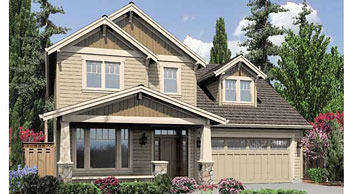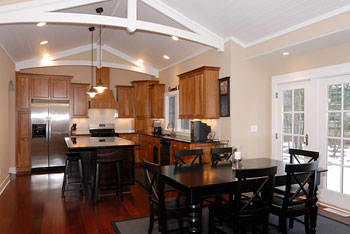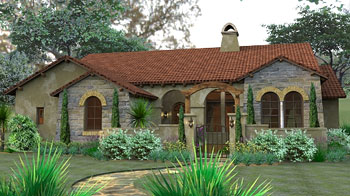Designing for Small Spaces
Whether your whole home is petite or you are simply researching design ideas for a small bathroom or kitchen there are plenty of tricks and tips for designing within small living spaces.
If you're designing a small home, remember the many benefits these petite spaces provide. They are less wasteful, more cost effective and packed with personality. Lowered utility costs, taxes and simplified maintenance make smaller homes quite desirable, especially in today's economy.
Flexibility and versatility are the two main components in designing for small spaces. The ability to work and play in your living space effectively is key, because a functional room always feels larger.
Here are some ways to benefits found in all small spaces such as coziness, security, intimacy, charm and functionality. Find the natural character of the room you are designing and then begin to add decorative accents.

Create extra space by incorporating features such as built-ins and window seats. Don't forget to utilize the space found under a sloping ceiling.
Planning is always an important component in interior design, but it is particularly crucial in designing for small spaces. Sit down and draw out a detailed layout of each room, including a supply list. Pay close attention to the potential uses for the room, furniture layout, storage spaces and of course, your personal style. Then decide on a budget for every room, to see if you need to make changes to your design plan.

Maximizing light and airflow is the key to creating a spacious feeling in a room. Relatively simple changes can make a difference in enhancing light like using metal, glass, polished wood and leather, which all reflect light to add to the brightness of a room.
Bring in the outdoors by having lots of large windows in key gathering rooms like the living room, dining room and kitchen.

Avoid single-point overhead lighting in small spaces since it tends to draw the walls in. Instead, increase the number of light sources (pendants and sconces are great for small rooms). To avoid glare (which is common in small spaces) creatively conceal your light sources with lampshades, angled spotlights or recessed lighting.
Choose compact furniture, because the size of the space needs to balance with the size of its furnishings. When selecting furniture, consider maximizing the functionality of each piece. For example, in a small dining room or breakfast nook the addition of benches provide extra seating and use less floor space than chairs.
When decorating your small space focus on simplicity to keep the space balanced. Paint and color selection are the easiest ways to achieve consistency. Here are some great tips:
- Paint only one wall a rich color, leaving the rest neutral.
- Most of the color palette of the room should be neutral, adding to the sense of space. Use darker and richer colors as accents.
- Choose cool colors, like blue and green, which are distance colors and make a small room appear larger.
BROWSE HOME PRODUCT ARTICLES
- Creating a Spa-Like Master Bathroom »
- Designing a Water-Efficient Bathroom »
- Design a Modern Bathroom »
- View All Bathroom Articles »
- Building a New Home »
- Building a Duplex »
- Finding the Right Home Builder »
- View All Building Tips Articles »
- Adding the Right Columns»
- Decorative Touches for Your Interior»
- Shutters for Every Architectural Style »
- View All Columns & Millwork Articles »
- How to Use Specialty Laminates »
- Decorative Touches for Your Home's Interior
- View All Countertops and Surfaces Articles »
- What Goes Into a Great Deck? »
- Decorative Touches for Your Home's Interior »
- View All Decking Articles »
- Choosing Glass for Your Entry »
- Stylish Personas for Your Front Door »
- Using Sidelites and Transoms »
- View All Door Articles »
- Choose Siding for Your Region »
- Get the Most Out of Exterior Paint »
- Mixing Siding to Define Your Exterior »
- View All Exterior Articles »
- Finding the Right Home Builder »
- The Appeal of Small House Plans »
- Choosing the Perfect Floor Plan »
- View All Finding a Home Plan Articles »
- Colorful Flooring for Your Home »
- Designing With Different Widths»
- Chic, Neutral, Gray Flooring »
- View All Flooring Articles »
- Garage Doors That Add Curb Appeal »
- Caring for Your Garage Doors »
- Benefits of Insulated Garage Doors »
- View All Garage Door Articles »
- Reclaimed Products for Your Home »
- Building a Green and Stylish Home »
- Benefits of Building with SIPS »
- View All Green Building Articles »
- Cool Gadgets for Your New Home »
- Creating a Hi-Tech Home »
- Efficient Gifts for New Homeowners »
- View All Home Electronics Articles »
- Improve Your Home's Air Circulation »
- How to Improve the Air Circulation in Your Home »
- View All HVAC Articles »
- Bedrooms Designed for Sleep »
- Selecting a Fireplace for Your Home »
- Crafting a Luxurious Master Suite »
- View All Interior Design Articles »
- Design the Perfect Outdoor Space »
- Dive into a Beautiful Pool »
- Design a Sizzling Outdoor Kitchen »
- View All Outdoor Living Articles »
- Apps to Help You Pick Paint Colors »
- Create the Perfect Mood with Paint »
- How to Read the Color Wheel »
- View All Painting & Decorating Articles»
- Creating a Spa-Like Master Bathroom »
- High-Impact Kitchen Upgrades »
- Creating a Water Efficient Bathroom »
- View All Plumbing Fixtures Articles»
- Cladding That Complements Your Exterior »
- Reasons to Consider Prefinished Siding »
- View All Siding & Cladding Articles»
- All About Solar Powered Skylights »
- Natural Lighting for the Dark Corners of Your Home »
- Design a Better Bedroom with Skylights »
- View All Skylight Articles»

